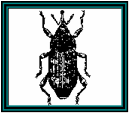The white pine weevil is one of the most serious pests of white pine in the area. Feeding damage rarely kills trees but can cause multiple leaders to develop on infested trees as the terminal leader is killed. Feeding injury can also stunt or distort trees.
Host Trees. Most seriously attacked: white pine, Norway spruce, and jack pine. Commonly attacked: pitch pine, Japanese red pine, western white pine, limber pine, foxtail pine, and red spruce. Occasionally attacked: Scotch pine, western yellow pine, mugo pine, and black spruce. Rarely attacked: red or Norway pine, Himalayan blue pine, blue spruce, white spruce, and Douglas fir.
Life History. The adults are reddish-brown weevils, approximately 1/4-inch long that are marked irregularly with patches of brown and white scales. Adults overwinter in litter on the ground and resume activity in April (7 to 58 Growing Degree Days) in southern New England. The weevils prefer small trees three to 15 feet in height and are more likely to attack trees in sunny locations. Adult weevils fly to the terminal shoots of host trees and feed on bark tissue. The weevils then chew small pits in the leader and lay their eggs there in May. The eggs hatch in seven to ten days. Legless larvae (grubs) feed on the inner bark and cambium layers that produce tree growth. When several larvae are feeding, the shoot is soon girdled and dies. The larvae mature and pupate inside the leaders. Adult beetles emerge from late June to early September. Spring egg-laying continues for a month or longer, and one shoot can contain larvae in various stages of growth. There is only one generation per year. After emergence, adult white pine weevils disperse by flying to new areas.
Damage. The first sign of attack ranges from small, glistening droplets to resin oozing from tiny holes in the leader. This is caused by adult weevils that are feeding before egg-laying. As the terminal is girdled, the new shoot of the current year’s growth withers, the tip bends over and turns brown. This is usually noticeable in mid-June. Examination of the dead shoots will show the white larvae or pupae beneath the bark or in the wood and pitch. The current year’s growth is always killed, but up to five year’s growth is commonly killed. Damaged trees develop a crooked, distorted appearance with forked branches.
Control. Cut and destroy infested leaders from the time the leader begins to wilt until the first half of July to kill the immature weevils developing inside. The leader should be pruned by cutting into healthy tissue below the area where weevil larvae are tunneling. Once the terminal leader is killed by weevil feeding injury, one or more lateral branches will take over and grow as the new terminal shoot. Please contact your local Cooperative Extension Center for chemical and other management options or visit the on-line guides of Cornell University and Penn State. Note: This information may not apply to your state or other geographical area.

By Milton G. Savos, Extension Entomologist (Emeritus), University of ConnecticutUpdated by Donna Ellis, Senior Extension Educator, UConn IPM Program, 2011.
Information in this document is for educational purposes only. The recommendations contained are based on the best available knowledge at the time of publication. Any reference to commercial products, trade or brand names is for information only, and no endorsement or approval is intended. The Cooperative Extension System does not guarantee or warrant the standard of any product referenced or imply approval of the product to the exclusion of others which also may be available. The University of Connecticut, Cooperative Extension System, College of Agriculture and Natural Resources is an equal opportunity program provider and employer.